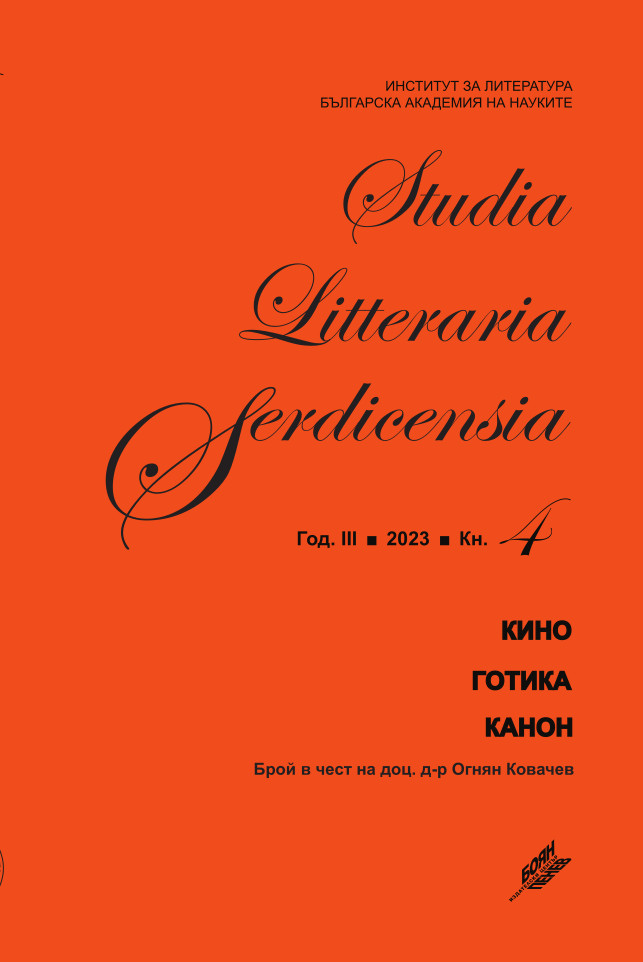The article outlines the parameters of the horrific in the Slavic mediaeval literature of Byzantine type. The aim of the research is to compare the mediaeval Slavic horrific with the Gothic version of the same category through a prospective approach. Translated and original Slavic-language works (different in origin, genre and style) from the IX to the XVII century have been analyzed, but later texts have also been used for comparison. Among the main contextual meanings of the Slavic mediaeval words for horror are: 1. ‘fear’, 2. ‘compassion’, 3. ‘fear combined with astonishment’, 4. ‘combination of wonder and delight’. Attention is paid to the significantly reduced presence of verbal signals of experience of horror-compassion in the Byzantine martyrs’ lives and, conversely, to the escalation of the feeling of horror in the Slavic versions of the vitas (in the works of St. Dimitry of Rostov). The common features which unite the mediaeval horrific and the Gothic one are above all the supernatural as a source of horror and the connection between the horror and the sublime. Revelation (to the mind) of the Divine plan for the salvation of people, which is the most sublime phenomenon in the history of the world, stimulates the theological activity of mind and arouses delight. In mediaeval Slavic texts, however, this delight is often referred to by the lexeme оужасъ and its derivatives. The reason for this is sought primarily in the Greek equivalent ἔκστασις, which tends to be used as a generic term for going beyond the usual emotional states, for any kind of extreme experience – positive or negative.
Horror in the Byzantine-Slavic Middle Ages and Western European Gothic Culture
-
YEAR: КНИГА 4PUBLISHED ON :
PUBLISHER: INSTITUTE FOR LITERATUREISSN (Print): 2738-7631ISSN (Online): 2815-2999
-
-

- NAME: Regina Koycheva, Asst. Prof. PhD
- INVERSION: Koycheva, Regina
- E-MAIL: [email protected]
- INSTITUTION: Institute for Literature – Bulgarian Academy of Sciences
- COUNTRY: Bulgaria
Регина Койчева, родена през 1974 г., е главен асистент в Института за литература при БАН и разработва интердисциплинарното поле между палеославистиката и теорията на литературата. Основният ѝ предмет на изследване са оригиналните старобългарски песнопения от IX и началото на Х в., върху които има редица публикации с теоретичен, литературноисторически и лингвистичен профил. Заедно с проф. д. н. Анисава Милтенова е съставител и редактор на сборника „Смъртта и погребението в юдео-християнската традиция“ (Studia Mediaevalia Slavica et Byzantina, том I, 2011). Завършила е Българска филология в Софийския университет „Св. Климент Охридски“. Докторската ѝ дисертация на тема „Ирмоси и словесни структури в триодните канони на Константин Преславски“ с научен ръководител проф. д. н. Георги Попов е защитена през 2005 г. Специализирала е при проф. Хайнц Миклас в Института по сла- вистика към Виенския университет (2005–2006; 2009) и при доц. Любор Матейко в Братиславския унивеситет „Ян Коменски“ (2018– 2019). Повече за Р. Койчева е публикувано тук: http://ilit.bas.bg/bg/ koicheva-regina.html
-
-
 ABSTRACT
ABSTRACTThe article outlines the parameters of the horrific in the Slavic mediaeval literature of Byzantine type. The aim of the research is to compare the mediaeval Slavic horrific with the Gothic version of the same category through a prospective approach. Translated and original Slavic-language works (different in origin, genre and style) from the IX to the XVII century have been analyzed, but later texts have also been used for comparison. Among the main contextual meanings of the Slavic mediaeval words for horror are: 1. ‘fear’, 2. ‘compassion’, 3. ‘fear combined with astonishment’, 4. ‘combination of wonder and delight’. Attention is paid to the significantly reduced presence of verbal signals of experience of horror-compassion in the Byzantine martyrs’ lives and, conversely, to the escalation of the feeling of horror in the Slavic versions of the vitas (in the works of St. Dimitry of Rostov). The common features which unite the mediaeval horrific and the Gothic one are above all the supernatural as a source of horror and the connection between the horror and the sublime. Revelation (to the mind) of the Divine plan for the salvation of people, which is the most sublime phenomenon in the history of the world, stimulates the theological activity of mind and arouses delight. In mediaeval Slavic texts, however, this delight is often referred to by the lexeme оужасъ and its derivatives. The reason for this is sought primarily in the Greek equivalent ἔκστασις, which tends to be used as a generic term for going beyond the usual emotional states, for any kind of extreme experience – positive or negative.
SUBJECT

